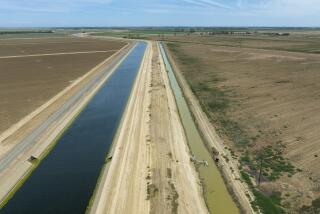Water: Getting Into the Spirit
At noon on Friday, Tony Romero, a spiritual leader of the Chumash Indians on the Santa Ynez Reservation, crouched over the hot, dry earth of Claremont. Slowly, deliberately, he lifted his bare feet.
Adorned with feathers and beads, the 67-year-old Romero began dancing to an ancient rhythm, beat on a drum and sticks by his children and grandchildren.
It was, he stressed, not a rain dance but a water dance. The event was meant to revere one of the Earth’s sacred resources--one that daily is becoming more precious and more scarce in Southern California.
Romero came to Claremont from Santa Barbara County, hardest hit in California’s continuing drought, to caution 100 water district officials, elected representatives and community leaders from the eastern San Gabriel Valley about the need to conserve water.
The Three Valleys Municipal Water District, which oversees water use by 500,000 residents of the eastern San Gabriel Valley, had invited Romero to appear at the gathering to help underscore the seriousness of the drought.
Of life on the reservation, Romero said, “We know how not to waste. What we knew from a long time ago can help people today. We know how to get along with the Earth. These are things that people need to understand and preserve the water we have now.”
That’s exactly the message that Three Valleys’ officials, worried that Southern Californians are not getting, want to highlight.
“We need to be equipped and prepared to deal with a very difficult situation,” the water district’s general manager, Richard W. Hansen, told the gathering. “As soon as 1991, we may have a (water) rationing situation in Southern California.
“We don’t want to suck up all the water now in the hopes that it’s going to rain later,” Hansen said. “That’s why we’re stressing conservation.”
Twenty years ago, Hansen said, the district relied on the Metropolitan Water District of Southern California for 30% of its supply. The rest came from wells and a lesser amount from rain runoff from the San Gabriel Mountains.
Now, he said, 65% of the district’s water comes from the MWD, which imports the water from Northern California and the Colorado River. The increase, Hansen said, results from population growth and the current water shortage.
Romero, noting that he once hand-carried 35 gallons of water a day for his family, said that he wasn’t really performing a rain dance on Friday.
But, he said, “We all have a secret desire to bring down the water. If a lot of people get down and pray hard enough, the voices would be heard. This is the way of Mother Nature.”
More to Read
Sign up for Essential California
The most important California stories and recommendations in your inbox every morning.
You may occasionally receive promotional content from the Los Angeles Times.










